American Shad: Connecticut’s State Fish
By Bobby Shipman
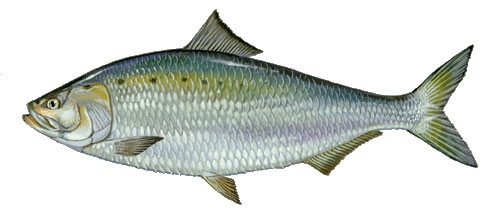
American Shad by Duane Raver, US Fish & Wildlife Service
The American shad is the Connecticut state fish. How can this obscure animal be that important? Throughout our state’s history, American shad has been a very special fish.
Thousands of years ago, Native Americans fished for shad in Connecticut’s rivers. In the 1600s they introduced shad to the European settlers. For Native Americans and the settlers the return of the shad was good news. Their supply of food from the last growing season was almost gone. Shad was a welcome source of fresh food. The Native Americans built weirs, which are stonewalls in the water. The ocean tide carried the fish into the weirs. When the tide went out, the fish were trapped and easy to gather.
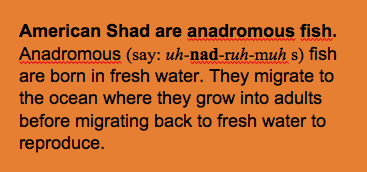 The life cycle of American shad begins when a female lays eggs far up a river or stream. A female American shad can lay up to 600,000 eggs! Male fish fertilize the eggs. The eggs hatch after 4 to 12 days.
The life cycle of American shad begins when a female lays eggs far up a river or stream. A female American shad can lay up to 600,000 eggs! Male fish fertilize the eggs. The eggs hatch after 4 to 12 days.
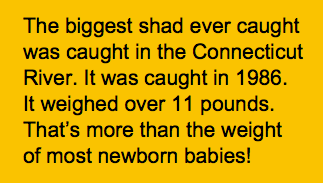 The babies spend their first summer in the fresh water. When they are big enough, they swim down river to the salty sea. Three to six years later, the fish is an adult. In the spring it returns to the river where it was born to begin the cycle again. American shad can grow up to 30 inches long. They typically weigh from 4 to 7 pounds.
The babies spend their first summer in the fresh water. When they are big enough, they swim down river to the salty sea. Three to six years later, the fish is an adult. In the spring it returns to the river where it was born to begin the cycle again. American shad can grow up to 30 inches long. They typically weigh from 4 to 7 pounds.
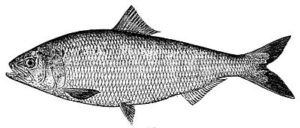 The time when shad come in from the ocean to the rivers each spring is called the shad run. The shad run became big business. In the 1700s and 1800s dried shad was one of Connecticut’s main products. It was shipped all over the world. But fishermen caught too many. The fish were caught before they could reproduce. By the late 1800s,
The time when shad come in from the ocean to the rivers each spring is called the shad run. The shad run became big business. In the 1700s and 1800s dried shad was one of Connecticut’s main products. It was shipped all over the world. But fishermen caught too many. The fish were caught before they could reproduce. By the late 1800s,  American shad had been overfished.
American shad had been overfished.
Shad faced another challenge. Dams were built on the Connecticut River in Enfield, Connecticut in the 1820s, and Holyoke, Massachusetts in 1849. The fish could not reach the place to lay their eggs. Later, pollution in the river also hurt them. By the 20th century, it looked like the end for American shad in Connecticut.
 But then came a glimmer of hope. Fish ladders were built to help the fish get around the dams. In 1955, the Holyoke Water Power Company built a fish elevator. (You can take a tour of the Robert E. Barrett Fishway in Holyoke in May each year.)
But then came a glimmer of hope. Fish ladders were built to help the fish get around the dams. In 1955, the Holyoke Water Power Company built a fish elevator. (You can take a tour of the Robert E. Barrett Fishway in Holyoke in May each year.)
Then in 1962 scientist Rachel Carson published a book called Silent Spring. It showed how pesticides were hurting the environment. Pesticides are poisonous chemicals sprayed on plants to keep bugs away. After it rained pesticides would flow from fields into rivers and streams. They were poisoning the fish. It got people thinking about taking care of the planet.
Finally in 1965 the Anadromous Fish Conservation Act became law. The law protected this type of fish. It limited the number of anadromous fish you could catch. American shad populations started to go up. They are still rising today.
American shad is still celebrated in Connecticut! Windsor holds a Shad Derby Festival every May. They have a parade, games, and shad fishing.
Essex has an annual shad bake in early June. Shad has lots of bones. After they’re removed, pieces of fish are nailed to oak planks. The fish is then roasted around a bonfire. Then it’s ready for eating!
See a video by ShorePublishingCT HERE
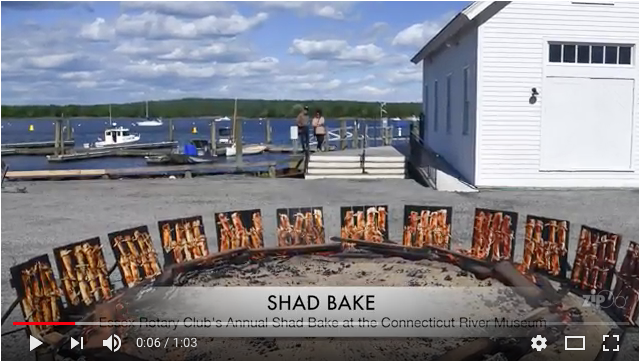
The Haddam Shad Museum in Higganum is dedicated to telling the story of American shad. In 2003 the American shad became the official Connecticut state fish. The enthusiasts who catch American shad along the Connecticut River every year are the biggest tribute to the fish’s legacy.
Read more about the Connecticut River HERE
Bobby Shipman is a fifth grader at Tariffville School in Simsbury. Read his other stories in WhereILiveCT.org.
“Shad: The Official State Fish,” Connecticut Explored, Spring 2006
“A Tale of Shad, the State Fish,” Connecticuthistory.org
Robert E. Barrett Fishway, http://www.hged.com/community-environment/fishway/default.aspx



 The life cycle of American shad begins when a female lays eggs far up a river or stream. A female American shad can lay up to 600,000 eggs! Male fish fertilize the eggs. The eggs hatch after 4 to 12 days.
The life cycle of American shad begins when a female lays eggs far up a river or stream. A female American shad can lay up to 600,000 eggs! Male fish fertilize the eggs. The eggs hatch after 4 to 12 days. The babies spend their first summer in the fresh water. When they are big enough, they swim down river to the salty sea. Three to six years later, the fish is an adult. In the spring it returns to the river where it was born to begin the cycle again. American shad can grow up to 30 inches long. They typically weigh from 4 to 7 pounds.
The babies spend their first summer in the fresh water. When they are big enough, they swim down river to the salty sea. Three to six years later, the fish is an adult. In the spring it returns to the river where it was born to begin the cycle again. American shad can grow up to 30 inches long. They typically weigh from 4 to 7 pounds. The time when shad come in from the ocean to the rivers each spring is called the shad run. The shad run became big business. In the 1700s and 1800s dried shad was one of Connecticut’s main products. It was shipped all over the world. But fishermen caught too many. The fish were caught before they could reproduce. By the late 1800s,
The time when shad come in from the ocean to the rivers each spring is called the shad run. The shad run became big business. In the 1700s and 1800s dried shad was one of Connecticut’s main products. It was shipped all over the world. But fishermen caught too many. The fish were caught before they could reproduce. By the late 1800s,  American shad had been overfished.
American shad had been overfished. But then came a glimmer of hope. Fish ladders were built to help the fish get around the dams. In 1955, the Holyoke Water Power Company built a fish elevator. (You can take a tour of the Robert E. Barrett Fishway in Holyoke in May each year.)
But then came a glimmer of hope. Fish ladders were built to help the fish get around the dams. In 1955, the Holyoke Water Power Company built a fish elevator. (You can take a tour of the Robert E. Barrett Fishway in Holyoke in May each year.)